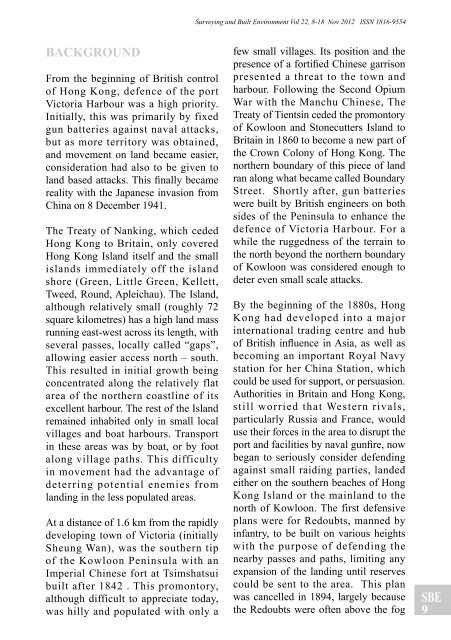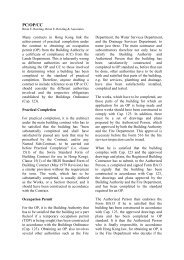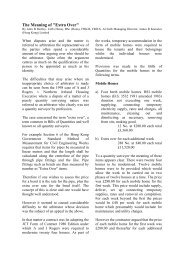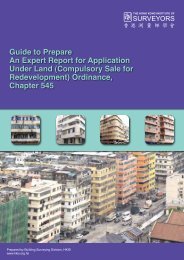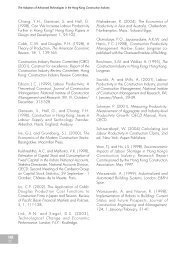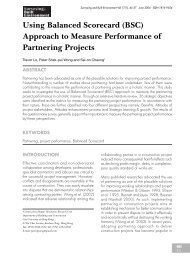Surveying & Built Environment Vol. 22 Issue 1 (December 2012)
Surveying & Built Environment Vol. 22 Issue 1 (December 2012)
Surveying & Built Environment Vol. 22 Issue 1 (December 2012)
Create successful ePaper yourself
Turn your PDF publications into a flip-book with our unique Google optimized e-Paper software.
BACKGRouNd<br />
From the beginning of British control<br />
of Hong Kong, defence of the port<br />
Victoria Harbour was a high priority.<br />
Initially, this was primarily by fixed<br />
gun batteries against naval attacks,<br />
but as more territory was obtained,<br />
and movement on land became easier,<br />
consideration had also to be given to<br />
land based attacks. This finally became<br />
reality with the Japanese invasion from<br />
China on 8 <strong>December</strong> 1941.<br />
The Treaty of Nanking, which ceded<br />
Hong Kong to Britain, only covered<br />
Hong Kong Island itself and the small<br />
islands immediately off the island<br />
shore (Green, Little Green, Kellett,<br />
Tweed, Round, Apleichau). The Island,<br />
although relatively small (roughly 72<br />
square kilometres) has a high land mass<br />
running east-west across its length, with<br />
several passes, locally called “gaps”,<br />
allowing easier access north – south.<br />
This resulted in initial growth being<br />
concentrated along the relatively flat<br />
area of the northern coastline of its<br />
excellent harbour. The rest of the Island<br />
remained inhabited only in small local<br />
villages and boat harbours. Transport<br />
in these areas was by boat, or by foot<br />
along village paths. This difficulty<br />
in movement had the advantage of<br />
deterring potential enemies from<br />
landing in the less populated areas.<br />
At a distance of 1.6 km from the rapidly<br />
developing town of Victoria (initially<br />
Sheung Wan), was the southern tip<br />
of the Kowloon Peninsula with an<br />
Imperial Chinese fort at Tsimshatsui<br />
built after 1842 . This promontory,<br />
although difficult to appreciate today,<br />
was hilly and populated with only a<br />
<strong>Surveying</strong> and <strong>Built</strong> <strong>Environment</strong> <strong>Vol</strong> <strong>22</strong>, 8-18 Nov <strong>2012</strong> ISSN 1816-9554<br />
few small villages. Its position and the<br />
presence of a fortified Chinese garrison<br />
presented a threat to the town and<br />
harbour. Following the Second Opium<br />
War with the Manchu Chinese, The<br />
Treaty of Tientsin ceded the promontory<br />
of Kowloon and Stonecutters Island to<br />
Britain in 1860 to become a new part of<br />
the Crown Colony of Hong Kong. The<br />
northern boundary of this piece of land<br />
ran along what became called Boundary<br />
Street. Shortly after, gun batteries<br />
were built by British engineers on both<br />
sides of the Peninsula to enhance the<br />
defence of Victoria Harbour. For a<br />
while the ruggedness of the terrain to<br />
the north beyond the northern boundary<br />
of Kowloon was considered enough to<br />
deter even small scale attacks.<br />
By the beginning of the 1880s, Hong<br />
Kong had developed into a major<br />
international trading centre and hub<br />
of British influence in Asia, as well as<br />
becoming an important Royal Navy<br />
station for her China Station, which<br />
could be used for support, or persuasion.<br />
Authorities in Britain and Hong Kong,<br />
still worried that Western rivals,<br />
particularly Russia and France, would<br />
use their forces in the area to disrupt the<br />
port and facilities by naval gunfire, now<br />
began to seriously consider defending<br />
against small raiding parties, landed<br />
either on the southern beaches of Hong<br />
Kong Island or the mainland to the<br />
north of Kowloon. The first defensive<br />
plans were for Redoubts, manned by<br />
infantry, to be built on various heights<br />
with the purpose of defending the<br />
nearby passes and paths, limiting any<br />
expansion of the landing until reserves<br />
could be sent to the area. This plan<br />
was cancelled in 1894, largely because<br />
the Redoubts were often above the fog<br />
SBE<br />
9


